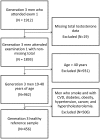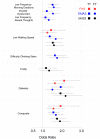Reference ranges for testosterone in men generated using liquid chromatography tandem mass spectrometry in a community-based sample of healthy nonobese young men in the Framingham Heart Study and applied to three geographically distinct cohorts
- PMID: 21697255
- PMCID: PMC3146796
- DOI: 10.1210/jc.2010-3012
Reference ranges for testosterone in men generated using liquid chromatography tandem mass spectrometry in a community-based sample of healthy nonobese young men in the Framingham Heart Study and applied to three geographically distinct cohorts
Abstract
Context: Reference ranges are essential for partitioning testosterone levels into low or normal and making the diagnosis of androgen deficiency. We established reference ranges for total testosterone (TT) and free testosterone (FT) in a community-based sample of men.
Methods: TT was measured using liquid chromatography tandem mass spectrometry in nonobese healthy men, 19-40 yr old, in the Framingham Heart Study Generation 3; FT was calculated. Values below the 2.5th percentile of reference sample were deemed low. We determined the association of low TT and FT with physical dysfunction, sexual symptoms [European Male Aging Study (EMAS) only], and diabetes mellitus in three cohorts: Framingham Heart Study generations 2 and 3, EMAS, and the Osteoporotic Fractures in Men Study.
Results: In a reference sample of 456 men, mean (sd), median (quartile), and 2.5th percentile values were 723.8 (221.1), 698.7 (296.5), and 348.3 ng/dl for TT and 141. 8 (45.0), 134.0 (60.0), and 70.0 pg/ml for FT, respectively. In all three samples, men with low TT and FT were more likely to have slow walking speed, difficulty climbing stairs, or frailty and diabetes than those with normal levels. In EMAS, men with low TT and FT were more likely to report sexual symptoms than men with normal levels. Men with low TT and FT were more likely to have at least one of the following: sexual symptoms (EMAS only), physical dysfunction, or diabetes.
Conclusion: Reference ranges generated in a community-based sample of men provide a rational basis for categorizing testosterone levels as low or normal. Men with low TT or FT by these criteria had higher prevalence of physical dysfunction, sexual dysfunction, and diabetes. These reference limits should be validated prospectively in relation to incident outcomes and in randomized trials.
Figures



References
-
- Bhasin S, Cunningham GR, Hayes FJ, Matsumoto AM, Snyder PJ, Swerdloff RS, Montori VM. 2006. Testosterone therapy in adult men with androgen deficiency syndromes: an Endocrine Society clinical practice guideline. J Clin Endocrinol Metab 91:1995–2010 - PubMed
-
- Bhasin S, Zhang A, Coviello A, Jasuja R, Ulloor J, Singh R, Vesper H, Vasan RS. 2008. The impact of assay quality and reference ranges on clinical decision making in the diagnosis of androgen disorders. Steroids 73:1311–1317 - PubMed
-
- Rosner W, Auchus RJ, Azziz R, Sluss PM, Raff H. 2007. An Endocrine Society Position Statement: utility, limitations and pitfalls in measuring testosterone. J Clin Endocrinol Metab 92:405–413 - PubMed
-
- Eskelinen S, Vahlberg T, Isoaho R, Kivelä SL, Irjala K. 2007. Biochemical reference intervals for sex hormones with a new AutoDelfia method in aged men. Clin Chem Lab Med 45:249–253 - PubMed
-
- Sikaris K, McLachlan RI, Kazlauskas R, de Kretser D, Holden CA, Handelsman DJ. 2005. Reproductive hormone reference intervals for healthy fertile young men: evaluation of automated platform assays. J Clin Endocrinol Metab 90:5928–5936 - PubMed
Publication types
MeSH terms
Substances
Grants and funding
- 1R01AG31206/AG/NIA NIH HHS/United States
- P30 AG031679/AG/NIA NIH HHS/United States
- U01 AR45614/AR/NIAMS NIH HHS/United States
- U01 AR045654/AR/NIAMS NIH HHS/United States
- N01 HC025195/HL/NHLBI NIH HHS/United States
- U01-AG027810/AG/NIA NIH HHS/United States
- U01 AR045583/AR/NIAMS NIH HHS/United States
- U01 AR45583/AR/NIAMS NIH HHS/United States
- U01 AR45632/AR/NIAMS NIH HHS/United States
- N01-HC-25195/HC/NHLBI NIH HHS/United States
- U01 AR45647/AR/NIAMS NIH HHS/United States
- R01 AG031206/AG/NIA NIH HHS/United States
- U01 AR045614/AR/NIAMS NIH HHS/United States
- U01 AR45654/AR/NIAMS NIH HHS/United States
- U01 AR045647/AR/NIAMS NIH HHS/United States
- U01 AR45580/AR/NIAMS NIH HHS/United States
- U01 AG027810/AG/NIA NIH HHS/United States
- UL1 RR024140/RR/NCRR NIH HHS/United States
- U01 AR045580/AR/NIAMS NIH HHS/United States
- U01 AG18197/AG/NIA NIH HHS/United States
- U01 AG018197/AG/NIA NIH HHS/United States
- 5P30AG031679/AG/NIA NIH HHS/United States
- U01 AR045632/AR/NIAMS NIH HHS/United States
LinkOut - more resources
Full Text Sources
Other Literature Sources

